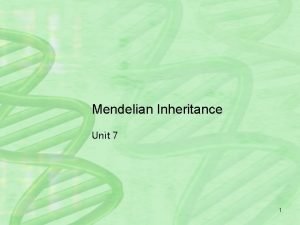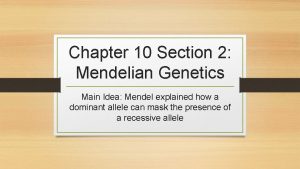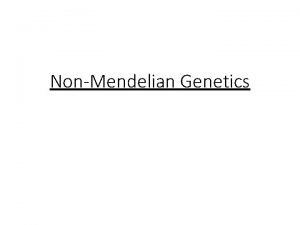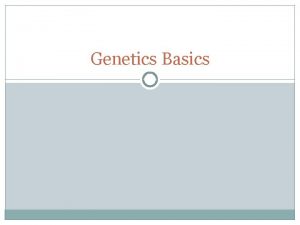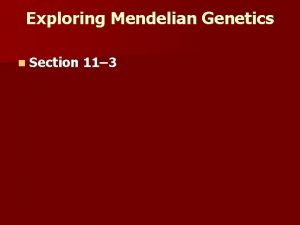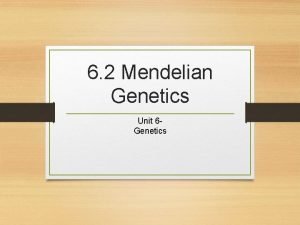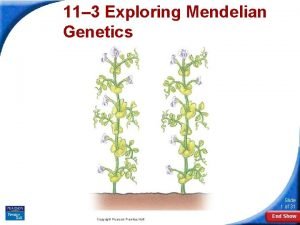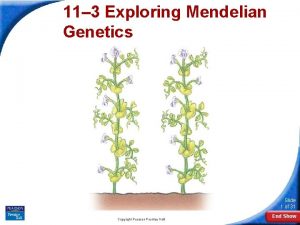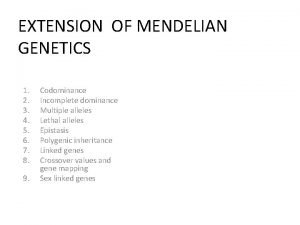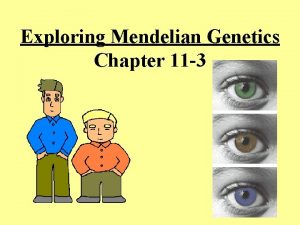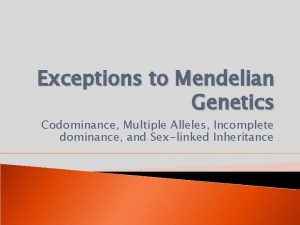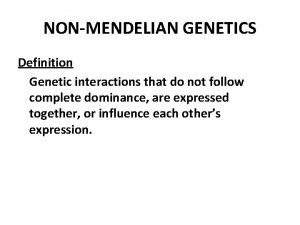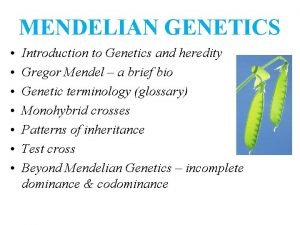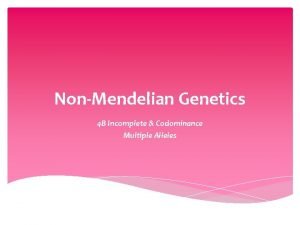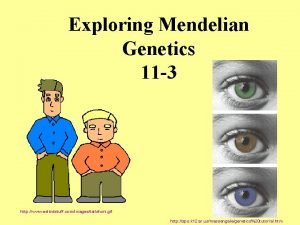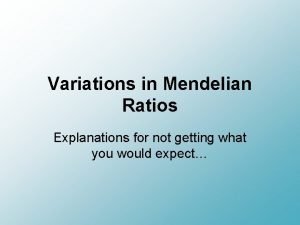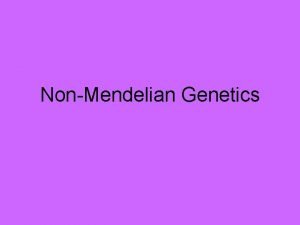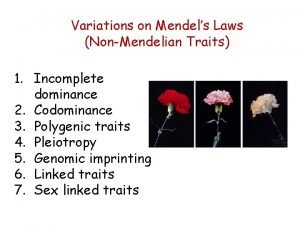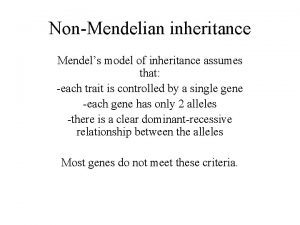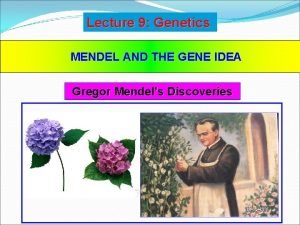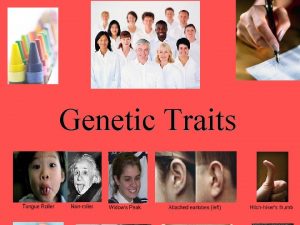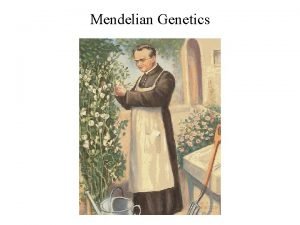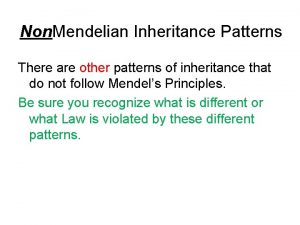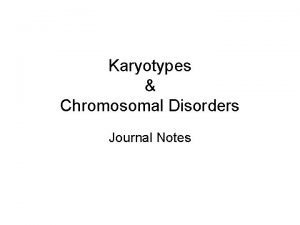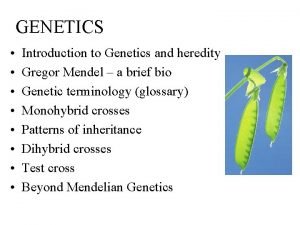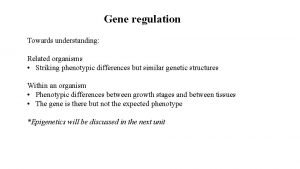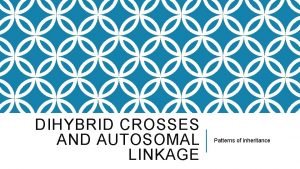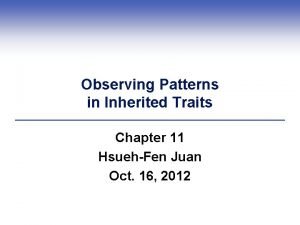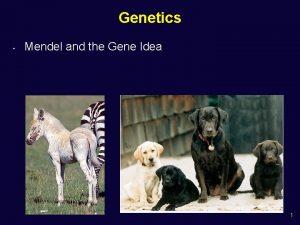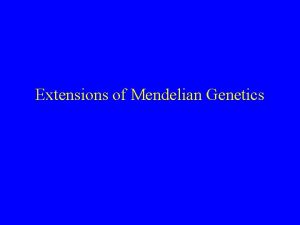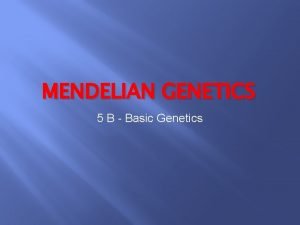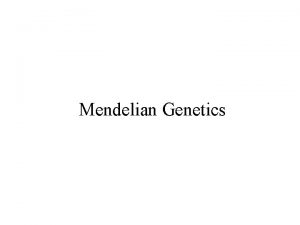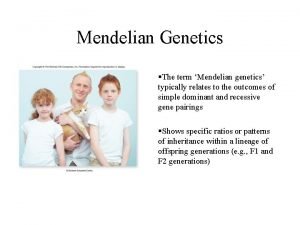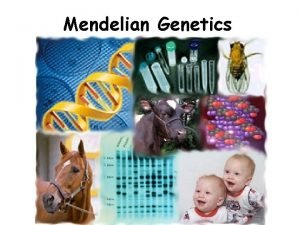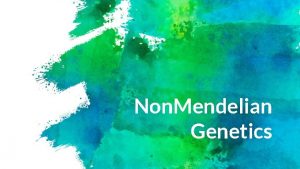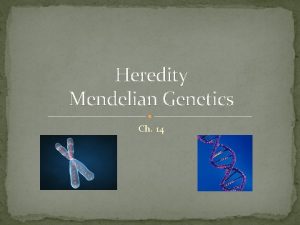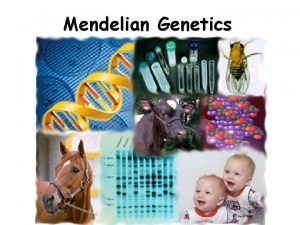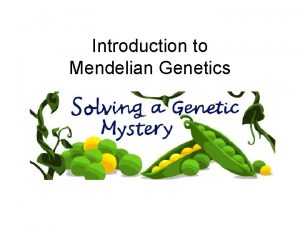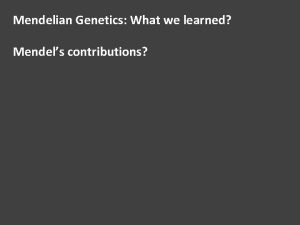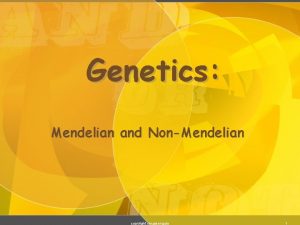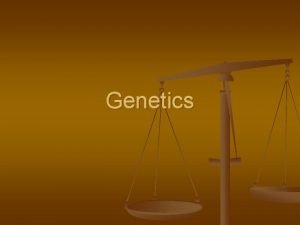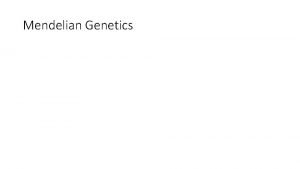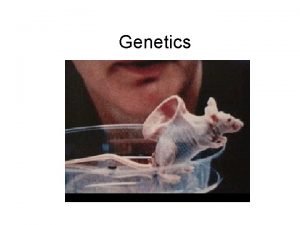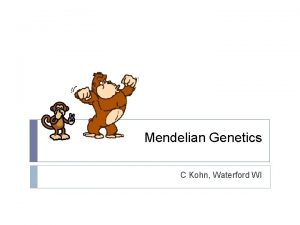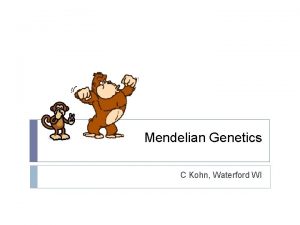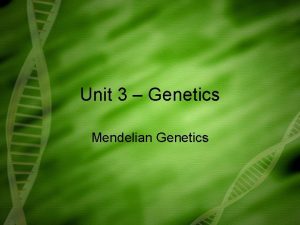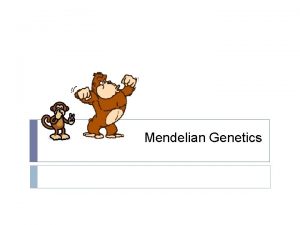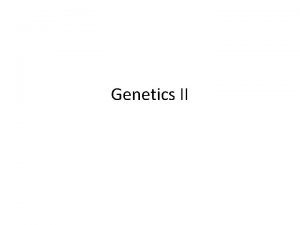Mendelian Genetics Chapter 6 Genetics What is Genetics
















































- Slides: 48

Mendelian Genetics Chapter 6

Genetics • What is Genetics? The scientific study of heredity • What is Heredity? – the passing of traits from parents to offspring

Genetics According to Brain Pop • http: //glencoe. mcgrawhill. com/sites/dl/free/0078759864/161752/ 00051105. html

What’s inside the cell…genetically speaking? Cell Nucleus Chromosome DNA Gene Trait Allele

Relate the word into the visual Cell Nucleus Chromosome DNA Gene Trait Allele

• = allele trait gene DNA • chromoso me nucleus cell

Visualizing and Connecting Vocabulary • Our CELL has a NUCLEUS • Inside the NUCLEUS are CHROMOSOMES • CHROMOSOMES are made up of DNA • DNA code for GENES • GENES carry ALLELES that code for the TRAITS that we have

Inheritance • You get your genes from your parents • In meiosis, half of the chromosomes in a pair come from the Dad, half come from the Mom • Chromosome: Thread-like structure within the nucleus that contains the genetic information passed from one generation of cells to the next • What we know today is based on the work of Gregor Mendel – Austrian monk

“The Father of Modern Genetics” Gregor Mendel – Austrian monk who laid groundwork for understanding biological inheritance – studied 7 inherited traits in pea plants (truebreeding) of his monastery garden – COUNTED the plants and compiled data (QUANTITATIVE APPROACH to science) Paper was published in 1866, but not enough was understood to truly value this work.

• WHAT TRAIT (CHARACTERISTIC) IS FARMER MENDEL LOOKING AT? • DO THE TWO PARENTS HAVE THE SAME TYPE OF TRAIT (ALLELE)? • Do all the offsprings look the same? Why?

Funny • http: //www. youtube. com/watch? v=wsg 7 q. M Okn. K 8 • http: //www. youtube. com/watch? v=NWqg. Z Un. Jd. AY

Key terms to know • Allele – each form of a gene for a certain trait (R or r) • Gene – sequence of DNA that codes for a protein and thus determines a trait • Genotype – combination of alleles for a given trait (RR or Rr or rr) • Phenotype – Appearance of trait (round seeds or wrinkled seeds) • Homozygous - when you have 2 of the same alleles for a given trait (RR or rr) • Heterozygous – when you have 2 different alleles for a trait (Rr)

Key terms to know • Dominant – Allele that is expressed, Represented by a Capitol letter. • Recessive – Allele that is masked or hidden, Represented by a lowercase letter. • F 1 generation: Filial or First Generation • Test cross (Punnett square): determine the genotype of an individual with a dominant phenotype

Penny Flip Vocabulary Check • Your pennies represent a set of chromosomes that code for a trait that you have. One penny is from Mom and the other is from Dad. They can donate to you only one side of the penny ( one allele) • Flip the pennies a total of 5 times recording the combinations you get from each penny • Convert the 5 combinations to the following Heads= H Tails=h Example: H/T= Hh T/T= hh Answer and label the following: Which combinations are homozygous, heterozygous, dominant, recessive Hh= heterozygous

Mendel’s Laws • Rule of Dominance- When the allelic combination of capital and lowercase come together the capital allele is stronger and is seen in the offspring • Law of Independent Assortment- Different traits found on the alleles are inherited and assorted independently from each other--> Remember in meiosis the chromosomes separate independently from each other • Law of Segregation- Two alleles for each trait must separate when the gametes are formed. The parent will pass on only one allele for each trait to each offspring during meiosis

Face Activity • Flip both popsicle sticks 8 times to determine the genotypes and phenotypes of your popsicle genetic face. Draw what it looks like • Choose a partner to work with and only ONE popsicle stick (since you only donate one set of chromosomes to your offspring) to repeat the activity as parents. • Record the allelic combinations of the baby, record it on the computer sheet along with drawing what the offspring’s face will look like. • Which parent does the face look more like? Mom or Dad

Figure 14. 1 A genetic cross

Mendel chose to use plants that were true-breeding… • P generation – parentals; true-breeding (On their own create identical offsprings) parents that were crosspollinated • F 1 generation – hybrid offspring of parentals that were allowed to selfpollinate • F 2 generation – offspring of F 1’s

Figure 14. 2 Mendel tracked heritable characters for three generations

Figure 11 -3 Mendel’s Seven F 1 Crosses on Pea Plants Section 11 -1 Seed Shape Seed Color Round Yellow Seed Coat Color Gray Pod Shape Pod Color Flower Position Smooth Green Axial Tall Short Wrinkled Green White Constricted Yellow Terminal Round Yellow Gray Smooth Green Axial *Flower color – purple (P) vs. white (p) Seed coat color and flower color are often put in for one another – thus, the EIGHT traits!!! Go to Section: Plant Height Tall

Mendel’s 4 ideas… 1. Alternative versions (alleles) of genes account for variations in inherited characters. 2. For each character, an organism inherits two alleles, one from each parent. 3. If the two alleles differ, the dominant allele is expressed in the organisms appearance, and the other, a recessive allele is masked. 4. The two alleles for each character segregate during gamete production. (Law of Segregation)

Figure 14. 3 Alleles, alternative versions of a gene

Figure 14. 4 Mendel’s law of segregation (Layer 2)

From the law of segregation…… • Came the Law of Independent Assortment Genes for different traits can segregate independently during the formation of gametes. In other words…. . Just because a seed is round does not mean that it has to be green.

Figure 14. 5 Genotype versus phenotype

Probability & Genetics

Punnett Square • Device for predicting the results of a genetic cross between individuals of a known phenotype. • Developed by R. C. Punnett • Rules: 1. must predict possible gametes first 2. male gametes are written across top, female gametes on left side 3. when read Punnett, start in upper left corner and read as if a book 4. WRITE OUT GENOTYPES IN ORDER


Example…… • Character – flower color • Alleles – Purple (P) and white (p) Note: Purple is dominant with a capital letter and white is recessive shown with a lowercase of dominant trait Genotypic combos possible – two dominants: PP (homozygous dominant) two recessives: pp (homozygous recessive) One of each: Pp (heterozygous)

Phenotypic possibilities – physical appearance • PP – purple • pp – white • Pp – purple (white is masked, but still part of genotype)

Monohybrid crosses – only one character considered Steps to do: • Write out genotypes of parents • Write out possible gametes produced • Draw 4 box Punnett square • Put male gametes on top, female on left side • Fill in boxes • Determine genotypes by reading Punnett starting from top left • Determine phenotypes by reading from genotype list Ex. 1. White flowered plant X Purple flowered plant 2. Yellow peas X Green peas 3. Tall plant X short plant

Dihybrid (Two-Factor)Cross • Because genes separate independently we can determine the possible outcomes of a two-factor cross. • Example: Mendel’s Peas F 1 Hybrids for Shape and Color: Rr. Yy Foil – First, Last, Inner, Outer Possible gametes passed on to offspring: RY, ry, r. Y, and Ry – Place in order (dominant to recessive) RY, Ry, r. Y, ry then place on cross


Beyond Dominant and Recessive • Incomplete Dominance One allele is not completely dominant over the other – something in the middle is expressed Ex. Red and White Snapdragons – Make Pink (Like mixing paints) p. 272 in your book Red – RR White – WW Pink – RW Only one phenotype for each one genotype


Beyond Dominant and Recessive • Codominance Both alleles are expressed in the phenotype Ex. Cow Hair Color RR – Red WW – White RW – Roan (Red & White) Homework – Codominance/Incomplete Dominance WS

Beyond Dominant and Recessive • Multiple Alleles Genes have more then two alleles Ex. Blood Type Color Coats in Rabbits A and B are also Codominant O is recessive CW/HW – Multiple Allele WS

More on blood types…. . • The blood type determines what antibodies are located within the blood. Type A blood has type B antibodies. If type B blood is put into their bodies, their immune system reacts as if it were a foreign invader, the antibodies clump the blood - can cause death. • Type AB blood has no antibodies, any blood can be donated to them - they are called the "universal acceptors" • Type O blood has no surface markers on it, antibodies in the blood do not react to type O blood, they are called the "universal donors"


Sex-linked Genetics Ex. Colorblindness

Chromosomes • How many pairs of chromosomes do humans have? • 23 • What is the difference between male and female chromosomes? • Pair #23 Male – XY and Females – XX Look at the following karyotype…can you tell the difference?

Karyotype – Picture of ______ Humans have a total of ___ chromosomes ___ from sperm cell & ___ from ____ cell Chromosomes 1 -22 Autosomal 23 Sex Question: Is this individual a Male or female?

What about genes located on the sex chromosomes? • Very few genes are located on the Y chromosome……Most are located on the X • So females carry two genes and males only one. • Draw a punnett square with the sex chromosomes……XX x XY Link the gene to the X only. EX: XC

Sex-Linked Genes • Ex. Colorblindness is carried on the sexchromosomes • It is a recessive trait – Xc How many genes do females need to express the trait (colorblindness)? 2 X c Xc How many genes do males need to express the trait (colorblindness)? 1 Xc. Y

Sex-Linked Punnett Square • Let C = Normal Vision and c = Colorblind • Cross: Normal Male ( ) x Carrier Female ( )

Sex-Linked Punnett Square C • Let C = Normal Vision and c = Colorblind • X C Y x X C X c = Normal Male x Carrier Female 1 st put male genotype C X Y on the top of the table & female genotype on the left side C X X c

Sex-Linked Punnett Square C • C – Normal Vision and c - Colorblind • X C Y x X C X c - Normal Male x Carrier Female 2 nd, cross them XC Y X C X c XC XC C X X c XCY c X Y

Sex-Linked Punnett Square C list the sex • C – Normal Vision and c - Colorblind 3 rd, and appearance C C c X Y x X X -Normal Male x Carrier Femaleof each possible offspring XC Y Offsprings: X C 1 Normal Female XC XC XCY 1 Normal (Carrier) Female 1 Normal Male X c C X X c c X Y 1 Colorblind Male
 Family resemblance test
Family resemblance test Extending mendelian genetics chapter 7
Extending mendelian genetics chapter 7 Chapter 10 section 2 mendelian genetics
Chapter 10 section 2 mendelian genetics Section 1 chromosomes and phenotype study guide a
Section 1 chromosomes and phenotype study guide a Punnett square color blindness
Punnett square color blindness Chapter 7 extending mendelian genetics vocabulary practice
Chapter 7 extending mendelian genetics vocabulary practice Codominance example
Codominance example Section 11-5 linkage and gene maps answer key
Section 11-5 linkage and gene maps answer key Heterozygous type a blood
Heterozygous type a blood Section 11-3 exploring mendelian genetics
Section 11-3 exploring mendelian genetics Mendelian genetics punnett square
Mendelian genetics punnett square Section 11-3 exploring mendelian genetics
Section 11-3 exploring mendelian genetics Section 11-3 exploring mendelian genetics
Section 11-3 exploring mendelian genetics Extending mendelian genetics answer key
Extending mendelian genetics answer key Extension of mendelian genetics
Extension of mendelian genetics Section 11-3 exploring mendelian genetics answer key
Section 11-3 exploring mendelian genetics answer key Multiple alleles
Multiple alleles Define pleiotropic gene
Define pleiotropic gene Codominance example
Codominance example Mendelian laws
Mendelian laws Mendelian genetics
Mendelian genetics Mendel's theory of particulate inheritance __________.
Mendel's theory of particulate inheritance __________. The scientific study of heredity *
The scientific study of heredity * Codominance
Codominance Heredity concept map
Heredity concept map 11-3 exploring mendelian genetics
11-3 exploring mendelian genetics Blood type matrix
Blood type matrix Non mendelian inheritance
Non mendelian inheritance Drug
Drug Non mendelian law
Non mendelian law Non mendelian law
Non mendelian law Cystic fibrosis mendelian inheritance
Cystic fibrosis mendelian inheritance Mendelian traits
Mendelian traits Pewarisan sifat non mendelian
Pewarisan sifat non mendelian Probability laws govern mendelian inheritance
Probability laws govern mendelian inheritance Mendelian inheritance patterns
Mendelian inheritance patterns Difference between mendelian and chromosomal disorders
Difference between mendelian and chromosomal disorders Punnett squares
Punnett squares Homozygous
Homozygous Recessive epistasis
Recessive epistasis Mendelian dihybrid test cross
Mendelian dihybrid test cross Mendelian traits
Mendelian traits In watermelons bitter fruit (b) is dominant
In watermelons bitter fruit (b) is dominant Mendelian
Mendelian Mendelian
Mendelian Chapter 22 genetics and genetically linked diseases
Chapter 22 genetics and genetically linked diseases Chapter 12 section 1 dna the genetic material
Chapter 12 section 1 dna the genetic material Chapter 12 molecular genetics answer key
Chapter 12 molecular genetics answer key Chapter 10 sexual reproduction and genetics
Chapter 10 sexual reproduction and genetics
